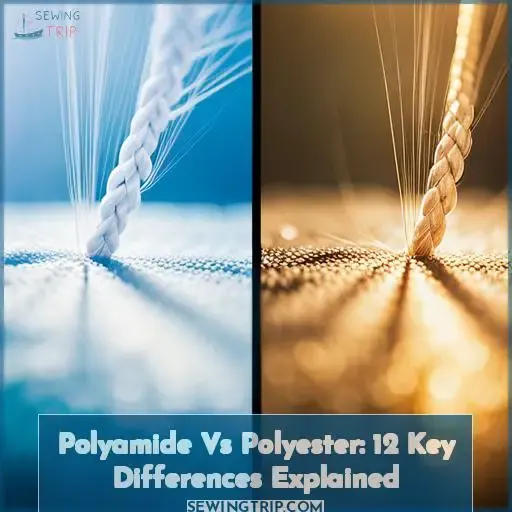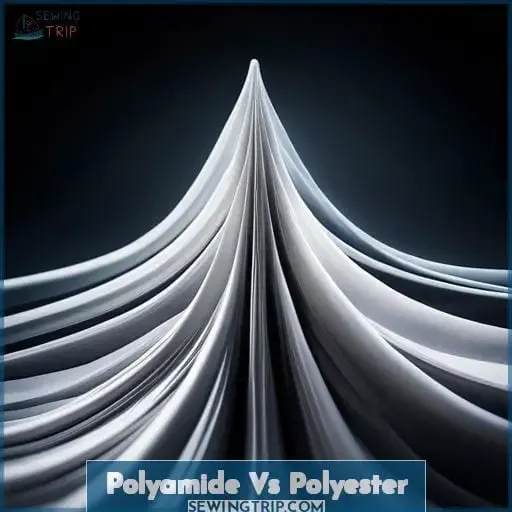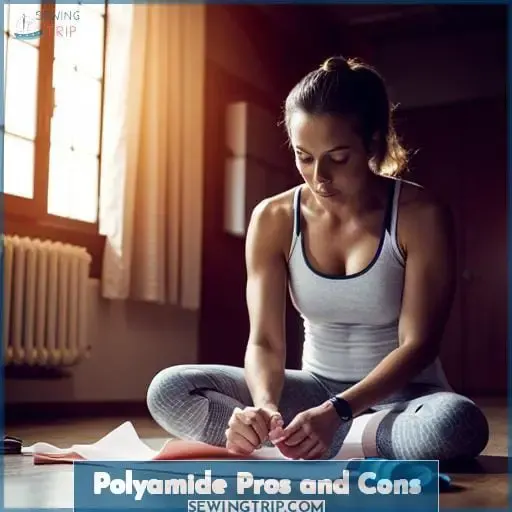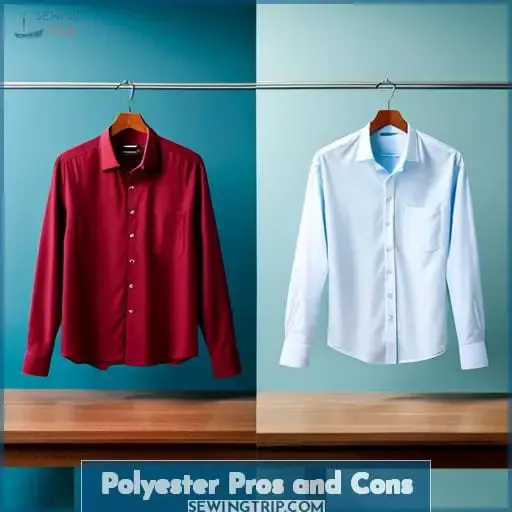This site is supported by our readers. We may earn a commission, at no cost to you, if you purchase through links.
 Polyamide and polyester have different properties and applications in textile manufacturing. While both are synthetic polymers, polyamide fibers tend to be softer and more flexible but less durable. Polyester is coarser but maintains shape and resists wrinkles. Polyamide requires more careful laundering to avoid pilling but dries quickly.
Polyamide and polyester have different properties and applications in textile manufacturing. While both are synthetic polymers, polyamide fibers tend to be softer and more flexible but less durable. Polyester is coarser but maintains shape and resists wrinkles. Polyamide requires more careful laundering to avoid pilling but dries quickly.
Polyester resists stains and abrasion despite producing static but takes longer to dry.
The polymers also have distinct production processes. Polyamide forms via step-growth polymerization of a diamine and dicarboxylic acid. Polyester instead undergoes condensation polymerization of ethylene glycol and terephthalic acid.
In terms of sustainability, polyester relies on non-renewable petroleum while some polyamides use renewable plant-based feedstocks. Both can be recycled but polyester is more commonly reused in clothing and other textiles.
Polyamide sees frequent use in hosiery, activewear, swimwear, and other apparel benefitting from its flexibility, comfort, and quick-drying properties. Polyester dominates outdoor gear and uniforms where its strength, shape retention, stain resistance, and low cost are advantageous.
Blends combine the positive attributes of each, resulting in fabrics with customized performance. Understanding their differing attributes allows selection of the appropriate fiber for a given textile application.
Table Of Contents
Key Takeaways
- Polyamide provides more breathability and flexibility, while polyester offers better shape retention and stain resistance.
- Polyamide feels softer initially, but polyester stands up better to long-term wear and abrasion.
- Polyamide works well for athleticwear due to its moisture wicking and stretch. Polyester provides stiffness and support.
- Polyester is superior for insulation in cold weather, but polyamide excels for moisture control in activewear.
Polyamide Vs Polyester
When selecting fabrics for apparel or home furnishings, it’s important to understand the unique properties of polyamide versus polyester. Polyamide tends to be softer, more breathable, flexible, and durable, making it well-suited for activewear and outerwear.
In contrast, polyester provides better insulation, dries faster, and resists shrinking and staining, ideal for sheets, sports shirts, and other everyday uses. Though both synthetics have environmental drawbacks in production, their characteristics lend themselves well to particular end uses.
Characteristics
You’d find polyamide softer and more comfortable against your skin, while polyester dries faster after washing. The polyamide fibers’ molecular structure makes the material more flexible and elastic, yielding a softer hand against your body.
Though polyester scores lower on comfort tests, its tighter weave resists pilling and stands up to frequent use and washing. Polyamide’s looser knit pills more easily, but feels cozier for loungewear and bases.
Polyester sheds water better thanks to its smooth surface that lets moisture slide off. The absorbent polyamide attracts and retains water, keeping sweat next to your skin rather than wicking it away.
For activewear, polyester pulls moisture from your body and transports it outward faster for quicker evaporation. Give polyamide’s breathability and ventilation the edge for hot climates, and pick polyester for insulation in cold weather.
Though your skin may prefer polyamide’s softer hand initially, polyester’s performance often outweighs comfort over time.
Uses
Sheesh, polyamide makes my stinky workout clothes feel like a fluffy cloud against my skin, but polyester sheets keep me from sweatin’ buckets through the night!
When you’re active, polyamide’s stretchiness and breathability keep you cool and unrestricted. The soft hand and moisture wickin’ make polyamide ideal for sun shirts and athletic wear touchin’ your skin.
Though polyester doesn’t feel as nice, its stiffness gives structured support. Polyester scores on odor control for intense workouts and on dryin’ speed when you’re in a rush.
For nighttime, polyester’s slick surface repels sweat to keep sheets dry. The tight weave and stiffness also resist pilling with frequent washing. Polyamide sheets would feel dreamy but show wear quicker. Though not as soft, polyester’s durability and sweat wicking deliver better nighttime performance.
Polyamide Pros and Cons
Breathability – Polyamide fabrics promote airflow and ventilate heat and moisture better than polyester.
Comfort – The soft handfeel and flexibility of polyamide create garments that move with your body comfortably. This softness also makes polyamide a popular choice for lingerie and loungewear.
Durability – Polyamide stands up well to abrasion and daily wear-and-tear. This rugged performance means polyamide outerwear and gear stays usable longer.
Stretch – The intrinsic elasticity of polyamide fibers like spandex gives them exceptional stretch and recovery.
Strength – Polyamide’s high tensile strength makes it resistant to tears, ideal for high-stress uses like ropes and parachutes.
However, some downsides to consider include:
Heat sensitivity – Polyamide fibers are prone to damage from high heat during laundering or ironing.
Cost – Polyamide is generally more expensive than polyester, which can drive up the prices of polyamide apparel and gear.
Sustainability – Like polyester, most polyamide isn’t biodegradable. Seek recycled polyamide or eco-friendly production methods when possible.
With an understanding of its strengths and limitations, you can determine if polyamide is the right synthetic fiber for your needs. Its softness, stretch, and breathability make it good for athleticwear and lingerie, while its durability suits outerwear and upholstery.
Polyester Pros and Cons
Focusing on polyester, you’ll find it dries faster than polyamide, so those pillowcases will be ready to use again in no time. The ’80s called and want their quick-dry fabrics back! Unlike polyamide, the hydrophobic quality of polyester fibers makes them ultra-moisture wicking.
Instead of absorbing perspiration, polyester fabrics move it to the surface where it quickly evaporates. That’s why activewear often combines polyester with natural fibers to keep you cool and dry. But don’t discard polyester’s heat retention abilities. That very lack of moisture absorption also means more air is retained around your body.
So those big puffy polyester jackets trap warmth incredibly well while resisting exterior dampness. Yes, polyester may pill more than polyamide, but its stain and odor resilience often outweigh a bit of pilling.
Slap some duct tape on your jackets’ friction points or invest in pilling-resistant polyesters. And static cling? Modern fabric finishes significantly reduce those annoyances without reducing polyester’s strong points.
So while the advantages of polyamide center around its inherent softness and flexibility, polyester’s pros stem from its durable water resistance and structure. That stable structure not only means it holds pleats and creases well but makes it effortless to care for.
Just toss it in the washer and dryer on low and you’re good to go. It will be wrinkle-free, ready to wear. But for those who prefer more natural fibers or the silky softness of polyamide, there are now eco-friendly polyesters made from recycled materials.
These are moving polyester solidly into the future as a responsible sustainable fiber. Choosing thoughtfully allows you to benefit from polyester’s practical perks without sacrificing style or values.
| Attributes | Polyester | Polyamide |
|---|---|---|
| Drying Time | Fast | Slow |
| Pilling Resistance | Low | High |
| Wrinkle Resistance | High | Low |
| Static | Can cling more | Less cling |
| Care | Machine wash & dry | Hand wash, line dry |
Production and Sustainability
Production and sustainability should be key considerations when comparing polyamide and polyester fabrics. As petroleum-based synthetics, these textiles represent significant portions of total synthetic fiber output.
However, recycled variations are growing in availability, decreasing waste and emissions while maintaining quality. Furthermore, innovative biodegradable versions that decompose within 3-5 years are emerging as well.
Though both are synthetics derived from petroleum, polyamide and polyester have differing production methods and sustainability profiles. With recycled and biodegradable options expanding, manufacturers can better minimize environmental impacts for these widely used materials.
As innovation continues, both fabrics may become more eco-friendly while retaining their functionality. By considering lifecycle impacts, producers can align polyamide and polyester with sustainability goals.
Production Methods
Sustainability-wise, both polyester and nylon production start from nonrenewable petroleum sources. So you’ll want to consider recycled options or emerging biodegradable versions if reducing waste is important to you.
As an experienced seamstress, I’m attuned to the impacts of textile manufacturing. Polyamide and polyester rely on high energy inputs, with concerning supply chains and waste streams.
However, innovations in production technology and waste management offer promise. Some manufacturers now capture emissions, recycle water, and convert waste into energy. Opting for recycled polyester and polyamide reduces environmental footprints, often with no loss of quality.
And biodegradable versions made from plant-based materials bring us closer to closed-loop systems.
There’s also potential for lower energy processes like electrospinning nylon. So while synthetics have drawbacks, technology and conscientious sourcing open paths to more sustainable fabrics. We can make informed choices and reward responsible practices with our purchasing power.
Recycling and Biodegradability
You can make a real difference by choosing recycled and biodegradable fabrics.
- Opt for recycled polyester and polyamide to reduce waste and emissions.
- Look for plant-based, biodegradable versions like polylactic acid (PLA).
- Support brands using sustainable farming for biobased fibers like bamboo or hemp.
These approaches help shrink the environmental impacts of our wardrobes. Recycling polyester and polyamide cuts petroleum reliance and landfill waste. Blending with biodegradable fibers allows clothing to fully decompose in 3-5 years.
And eco-friendly agricultural practices reduce pesticides in biobased textile supply chains. Whether it’s polyamide yoga pants, polyester blouses, or hemp hoodies, we vote for sustainability with each purchase.
Which is Better for You?
When comparing fabrics for clothing, think about your needs for comfort, durability and care. Both polyester and polyamide have advantages and disadvantages when it comes to how they feel and wear.
| Polyester | Polyamide | |
|---|---|---|
| Breathability | Less breathable due to lack of absorbency. Moisture gets trapped. | More breathable thanks to moisture absorption and permeability. |
| Thermal Retention | Better insulation and warmth thanks to low moisture absorption. | Less warm since it absorbs moisture. |
| Odor Resistance | Odor-resistant. Doesn’t absorb bodily oils and fluids. | Absorbs odors and oils more readily. |
| Abrasion Resistance | Moderate. Withstands some rubbing but pills with friction. | High abrasion resistance. Resilient against friction and rubbing. |
| Color Fastness | Excellent color retention. Resists fading. | Colors fade faster, especially in sunlight. |
| Softness | Crisp handfeel. Stiff fibers with little drape. | Softer drape and flexibility. Comfortable next to skin. |
Polyester excels at retaining heat and resisting odors. It also dries quickly. However, the stiff polyester fibers may cause discomfort. Meanwhile, softer polyamide breathes better thanks to its moisture absorption and permeability.
However, polyamide shows wear sooner while also absorbing odors and moisture more readily.
You’ll want to plan your activities accordingly and consider blending the fabrics to balance the benefits. With knowledge of their technical properties, you can select the right synthetic fiber for your needs.
Both fabrics serve distinct roles, so choose the one that best aligns with your lifestyle and values.
Frequently Asked Questions (FAQs)
How do polyester and polyamide fabrics feel on your skin? Polyamide tends to feel softer and more comfortable against the skin, while polyester can feel stiff or scratchy.
You feel polyamide’s soft caress against your skin, while polyester’s stiffness scratches. Polyamide flows with your body’s movements, conforming to your shape. Polyester remains rigid; its harsh texture chafes as you stretch and bend.
Polyamide whispers comfort, polyester shouts discomfort. Choose wisely for the fabric touching your skin.
Which fabric is better for athletic performance apparel? Polyamide is more breathable, flexible, and moisture-wicking, making it preferable for activewear.
Strong yet breathable polyamide excels in activewear. This synthetic comprises 11% of global fiber production yet dominates performance apparel. Its soft and flexible nature provides unrestricted movement as you pursue athletic feats or outdoor adventures.
Which fabric holds up better over time and many wash cycles? Polyamide is generally more durable and resistant to abrasion over long-term wear.
You betcha polyamide’s the winner for durability! Its mighty strong fibers laugh at years of wear, practically impervious to fraying. This fabric is your trusty sidekick through countless escapades. While polyester serves its purpose, polyamide is your champion for the long haul.
Which fabric is easier to dye or print designs on? Polyester takes dye more readily and holds color better than polyamide.
Polyester absorbs dye readily and retains vivid colors through repeated washings. Its molecular structure binds securely with dye molecules. Polyamide fibers resist absorbing dye as deeply, so colors fade faster.
Garment labels specifying cold, gentle wash cycles help prolong polyamide’s more muted hues.
Which fabric is more eco-friendly or sustainable? Neither fabric is biodegradable, but recycled polyester and polyamide help reduce plastic waste and emissions.
You’re right – neither polyester nor nylon are eco-friendly synthetics. But recycled versions of both substantially reduce waste and emissions without sacrificing quality.
Conclusion
So reader, after perusing this array of polyamides and polyesters, which do you think is the best fiber technology for you? While both boast various properties that excel at specific applications, no clear winner arises.
Ultimately, your choice comes down to your needs – from closet to carpets. Seek versatility? Nylon. Crave softness? Polyester. Demand durability? Polyamide. And fret not; recycling and greener options exist to still get that coveted garb or flooring.
At day’s end, trust your own preferences to serve you well. The fabric of our lives starts with knowing oneself.











